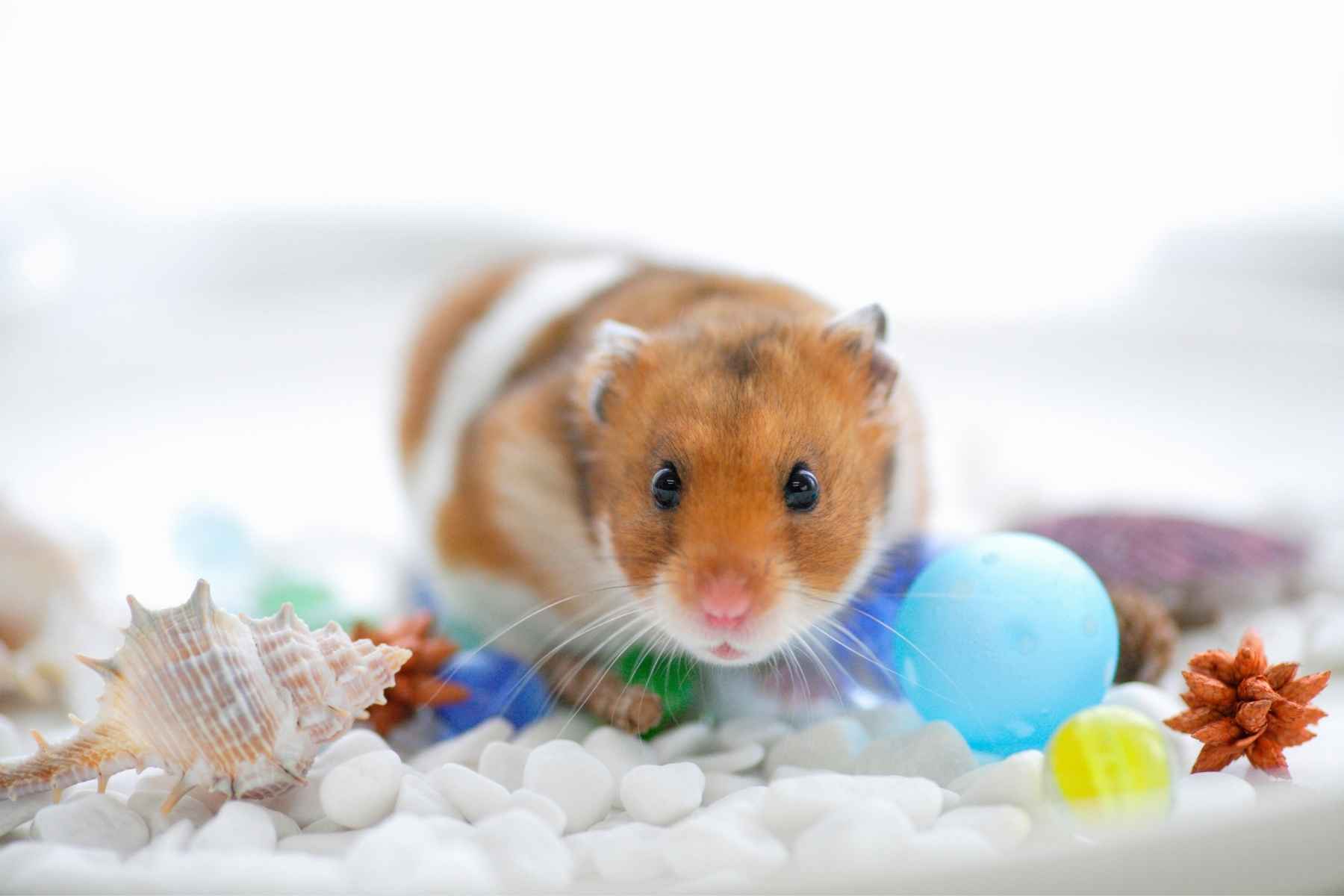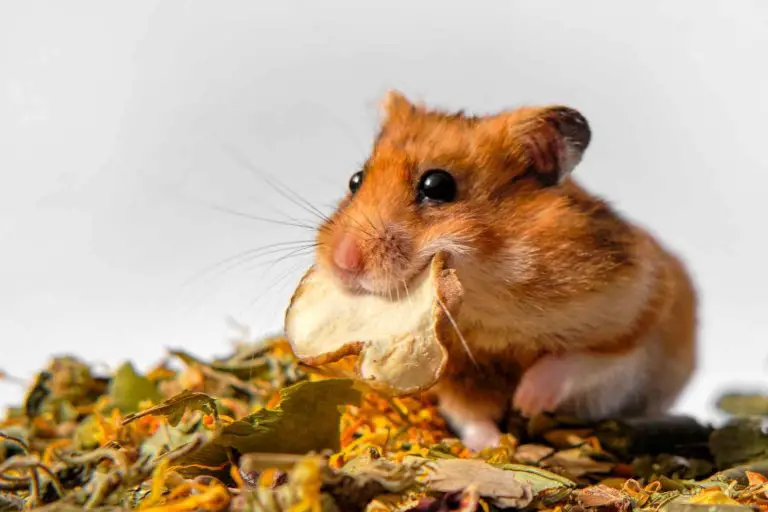Are Hamsters Color Blind?

Hamsters are wonderfully entertaining, easy to care for, and a memorable first pet for many people. They are low maintenance, low cost, and make a great addition to any loving household.
Their sweet faces and exuberance bring us no end of joy and great cute moments, but if you’re anything like me, then you’ve probably wondered what a hamster is thinking from time to time.
What are they thinking behind those adorable little button eyes? One common question people wonder about their hamsters is whether they are color blind.
Hamsters are color blind. Their eye is comprised of only 3% color-perceiving cones. Some breeds can see color in varying shades of either green or blue on the color spectrum, depending on the breed.
There’s a lot of fascinating science behind why a hamster is color blind, and surprisingly, different species of hamsters have different color vision.
Understanding a hamster’s vision is essential in keeping them safe when they’re out of their cage. The rest of this article will define color-blindness, why hamsters are color blind, and how well they can see.
What Makes Hamsters Color Blind?
Color blindness is defined as the absence or damage of cone types that can identify different colors. Humans, for example, are trichromatic, meaning that we have three different types of cones to tell colors apart, but that’s not all the color that’s out there.
Shockingly, birds and a few invertebrates have four different types of cones and can see colors in a wider spectrum than we can.
Technically speaking, all humans are color blind to those outside the visible spectrum, such as ultraviolet and infrared rays. Other animals, such as dogs, are dichromatic and cannot distinguish the colors red and green.
Hamsters are monochromatic, which indicates that they almost exclusively see things in black and white. However, hamsters can still see some colors even with such a low density of cone cells.
An interesting study concludes that Syrian hamsters can see certain shades of green, while Siberian hamsters can reportedly see some blue and ultraviolet shades.
Sadly, that means that your little furry friend doesn’t appreciate his favorite red wheel because it’s so bright and colorful.
Why Are Hamsters Color Blind?
Hamsters have very little in the way of color perception. Their eyesight is pretty poor, but as it turns out, they don’t need to see well to have a good survival toolkit.
They make up for it with an acute sense of smell. Hamsters get more excited at your smell than the sight of you― probably because you look like a blurry grey blob to them.
Hamsters don’t need color vision because they can perfectly recognize each other and you by smell alone. Wild hamsters also rely on their incredible nose to locate potential food sources and predators.
In addition, all hamsters are equipped with excellent hearing, making color vision unnecessary for their survival.
Their ears can detect it all― a bird’s wing-flapping overhead, the body of a snake slithering on the ground, the patter of feet through the underbrush― and they are quick to retreat if they sense danger.
This is why you might spot your hamster tensing and freezing up to listen if you dropped something near his cage. It’s an instinct to figure out the source of the noise and determine if there’s a threat out there.
Wild hamsters utilize these incredible senses at nighttime when they forage for food.
Color isn’t a helpful indicator to warn hamsters of danger when it’s dark outside. Most nocturnal animals, both predator and prey, cannot see color well, if at all.
Wild hamsters also spend most of their time tucked away in their burrows during the daytime, safe from the dangerous creatures above. They have no real need to take in any colors― the information isn’t helpful to them.
They identify food sources by smell, not by color as we humans do, and their eyes primarily function to help prevent them from bumping into things. They are very well suited for night vision, although they cannot see in complete darkness.
Can You Improve a Hamster’s Color Vision?
The advent of glasses for color blind people that restore color might deceive you into thinking that color therapy can help your furry friend experience the world in more color. Still, it simply isn’t possible to get your hamster to experience the world the same way we do.
First, color-blind glasses do not ‘add’ color to a person’s vision who is missing a type of cone in their eye; instead, they change the saturation level in the anomalous colors to help the color-blind person identify them more easily.
Hamsters, being monochromatic, simply cannot benefit from such tools and wouldn’t know how to use them even if they did.
Other Interesting Features of a Hamster’s Eye
Hamsters are born blind for the first two weeks of their lives. They have very weak eyesight when they develop, especially when exposed to bright light.
This is due to how a hamster’s eye is designed to allow maximum light in dark environments to see a wide area close to them. You might find them shying away from your company during the day if it’s too bright for them.
UV light signals to your hamster that it’s time for bed, and since wild hamsters don’t interact with UV light, your domestic hamster won’t appreciate being awoken by bright light. Their eyes are just too sensitive.
Ensure their cage isn’t exposed to direct sunlight throughout the day and avoid putting a light on their cage. They don’t need it, and the extra light will damage their eyes. Hamsters also have poor depth perception and can’t judge heights very well.
Always exercise caution and be vigilant when your hamster is playing on a table or countertop to avoid the risk of injury. In addition, you should keep sharp objects out of reach and out of the cage to prevent any trauma to the eye.
If you have high platforms in your hamster’s cage, make sure that you put in safeguards so that your hamster can’t fall to the bottom of the cage in the event of a fall.
Hamsters are pretty clumsy, and you want to take precautions so that they don’t injure themselves.
Hamster Eye Conditions
Sometimes, due to conditions in their environment or genetic predispositions, a hamster can develop certain eye conditions, some of which are life-threatening. Hamsters often injure themselves due to their poor eyesight and depth perception.
Pink eye is a common occurrence that can happen in a traumatic event or an unclean environment. This is characterized by a discolored ‘eyepatch’ around the eye, which is the inflammation of the pink tissues in the area.
Ulcers can be caused by damage to the eye and are accompanied by bleeding in the area. If you suspect your hamster has an eye condition, you should contact your local veterinarian.
Frequently Asked Questions
How Well Can Hamsters See?
Relative to humans, hamsters have a vision of 20/400. They find it very difficult to see objects until they are very close. On the other hand, they can see a wide area around them, allowing them to spot an encroaching predator.
Can Hamsters See Well in the Dark?
Hamsters can see better in dim or low light environments and are well adapted to traversing terrain with minimal light, but they cannot see if it is pitch black.
Conclusion
Hamsters are fascinating creatures with many interesting biological features that help them survive. If you’ve ever watched your hamster look around and wondered whether they can appreciate the colors in the world around them, you’re not alone.
Unfortunately, these adorable rodents can’t see color except blue and green. Syrian hamsters can see in shades of green, while Siberian hamsters only see in shades of blue.
Their eyesight is pretty bad, too, and they will only see something clearly if it is directly in front of their nose; however, they more than make up for their lack of vision with astute hearing and smell that can help protect them from predators in the wild.
Hamsters are nocturnal, so don’t be surprised if they’re romping around and getting some cardio in at 3 am. Since they are adjusted to a nocturnal lifestyle and their eyes cannot handle too much light, be sure to avoid putting their cage in the direct sunlight.
These pint-sized bundles of joy can offer a lot of entertainment and value to our lives, but understanding just how they see the world and what they can see helps us as owners better understand how to take care of our hamsters so that they can have a long, carefree life.






